How Much Do Solar Street Lights Cost?
There’s a multitude of solar street light variants available on the…
There’s a multitude of solar street light variants available on the…
Solar street lights have three important brightness metrics: candela, lux, and lumens.
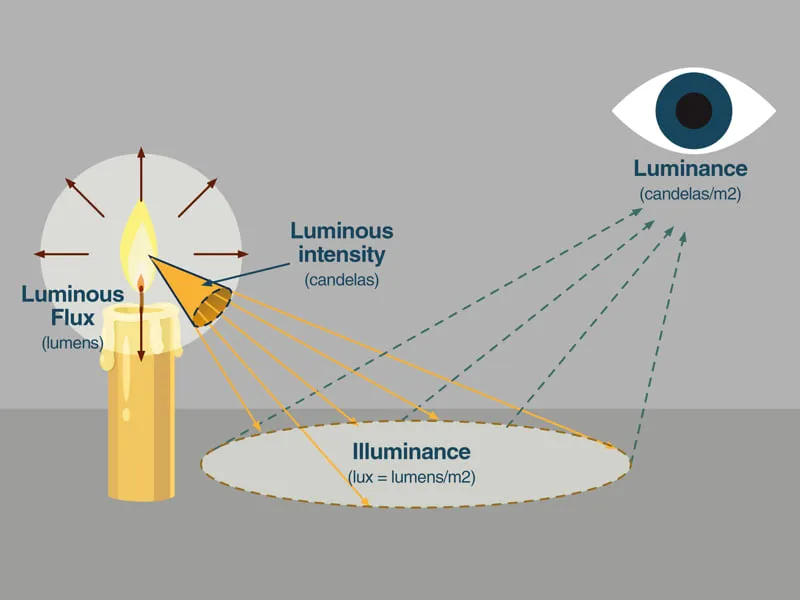
Methods for Measuring Brightness, Luminous Intensity, and Illuminance
Lumens: Lumen values are measured using an integrating sphere. The lumen value of a luminaire is typically labeled on the product packaging, allowing buyers to directly assess the brightness of the luminaire based on the lumen value.
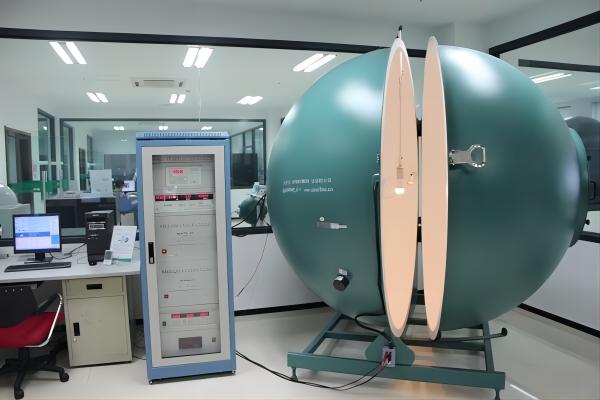
Lux: Lux is measured using a lux meter.
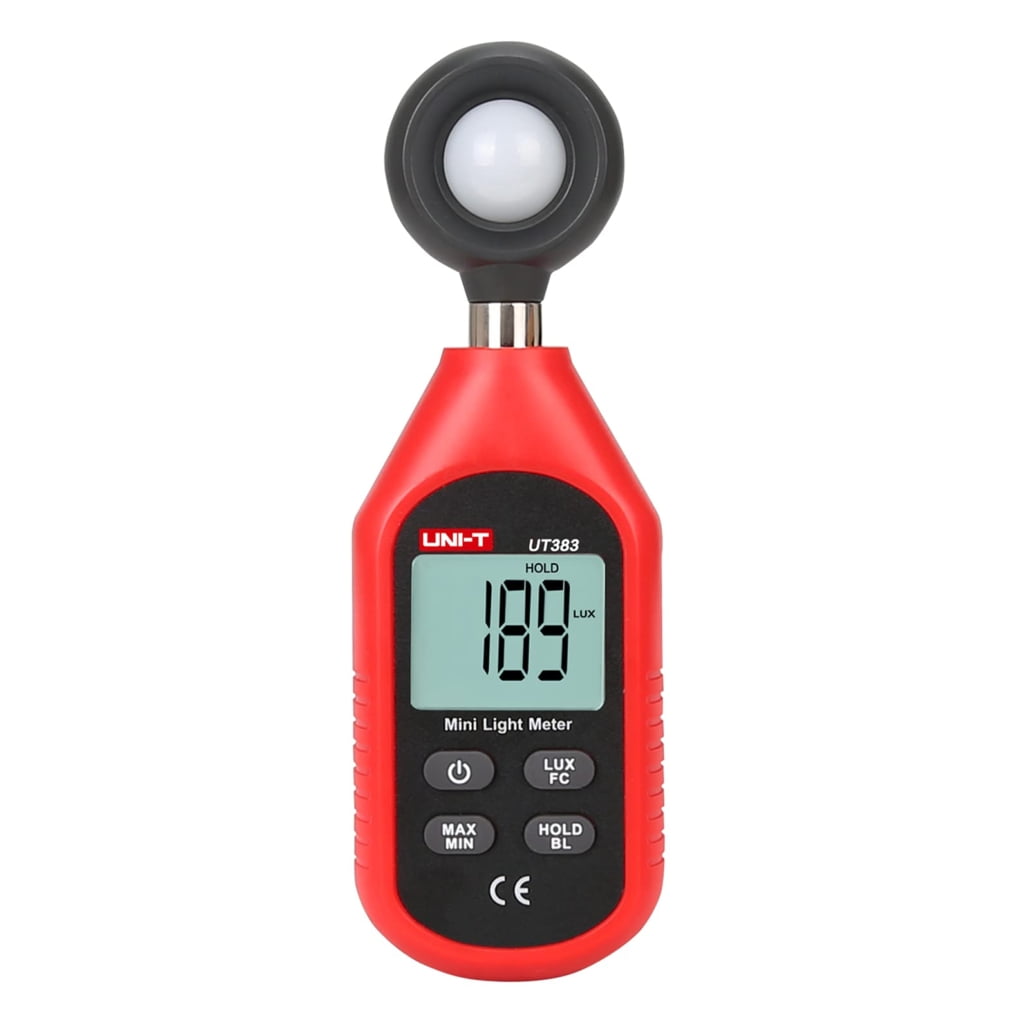
Candela: For simple measurements, a portable photometer can be used. However, for engineering projects, a large professional radiometer is required to generate a complete report.
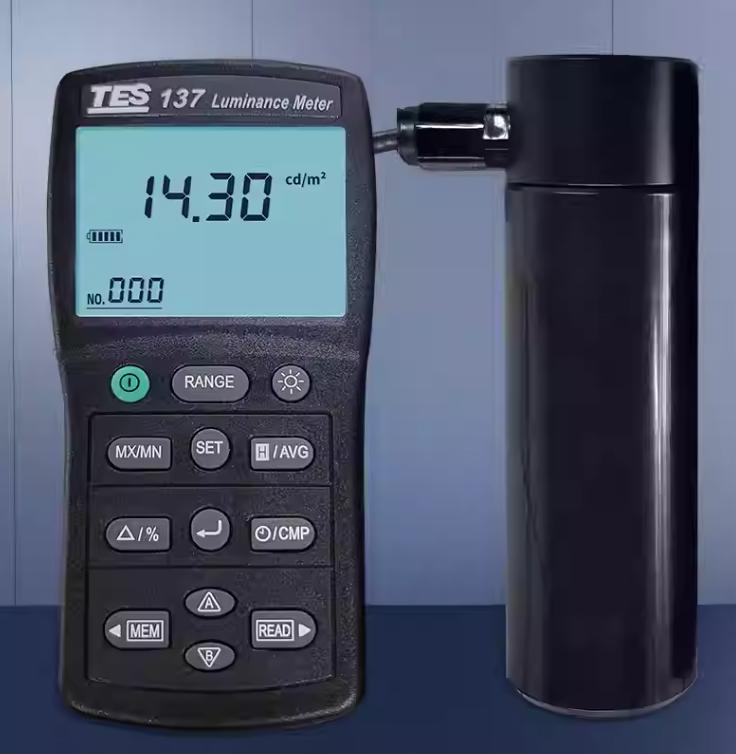
Here is a table summarizing the key points:
| Metric | Definition | Measurement Method |
|---|---|---|
| Lumens | Total amount of light emitted | Integrating sphere |
| Lux | Luminous flux per unit area | Lux meter |
| Candela | Luminous intensity in a specific direction | Photometer (simple measurements) or radiometer (engineering projects) |
There are two important indicators of the brightness of the solar street light, Lux and Lumens.
Lux and lumens are both units of measurement for brightness. They are used to tell us the amount of illumination output and the brightness of the light falling on a given surface.
Lumens equals light output.
Lux (represented as lx) stands for luminous flux per unit area.
Relationship between lumens and lux:One lux is equal to one lumen per square meter (lm/m2).
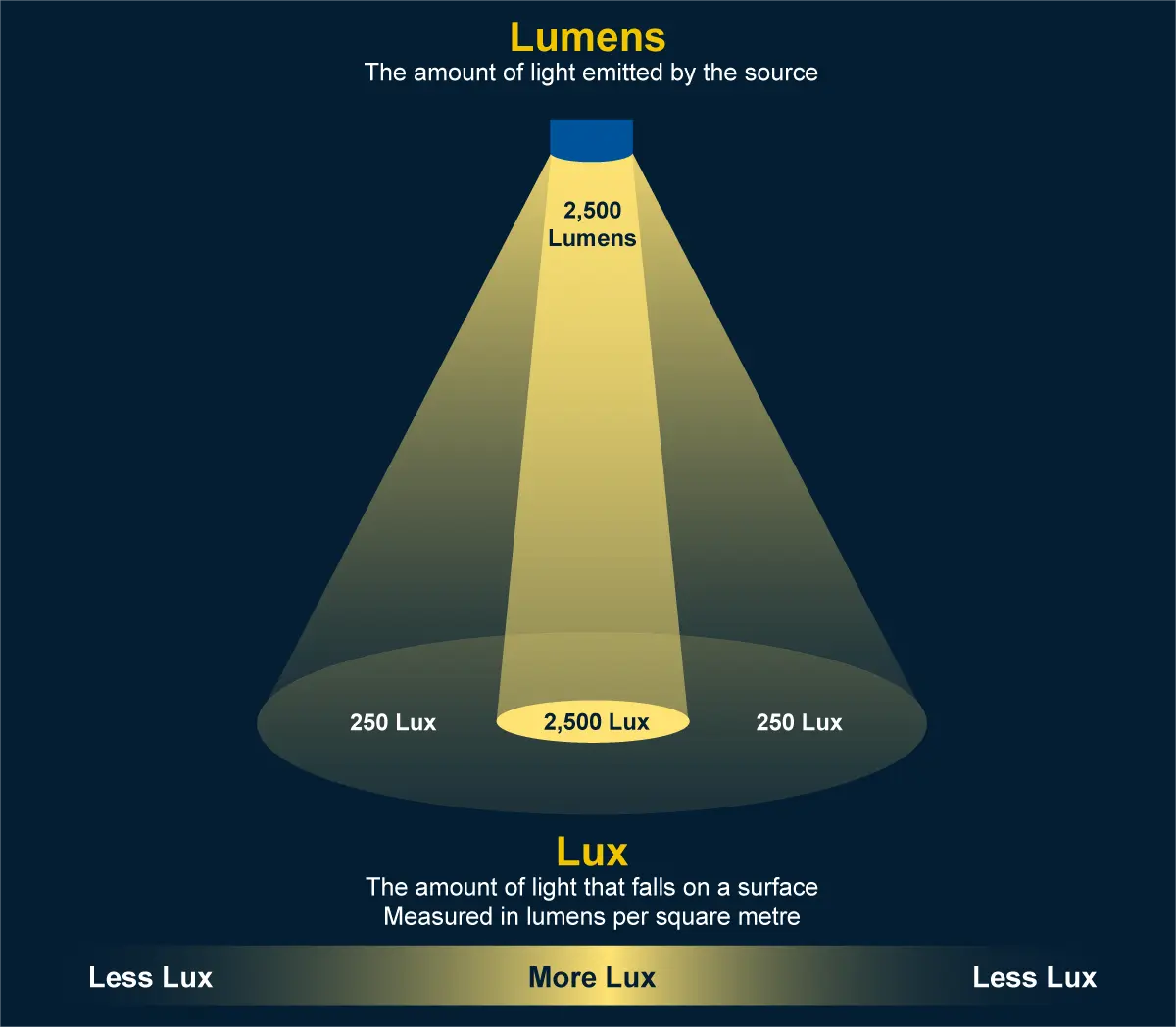 In this post, we will explore the Lux standards of street lights and why they are important. If you want to learn about lumens you can check out this article:UNDERSTANDING WATTS AND LUMENS: HOW TO CHOOSE THE RIGHT BRIGHTNESS LIGHT FIXTURE FOR YOUR PROJECT
In this post, we will explore the Lux standards of street lights and why they are important. If you want to learn about lumens you can check out this article:UNDERSTANDING WATTS AND LUMENS: HOW TO CHOOSE THE RIGHT BRIGHTNESS LIGHT FIXTURE FOR YOUR PROJECT
Lux is a measurement of the light flux falling on a surface. Lux is the international unit of photometry, a method for measuring light intensity. Lux is used to specify the brightness of light or illumination. It is a standard light measurement for all types of lighting, such as household lights, office lights, car headlights, or street lights.
Lumens measure the light output of a single light source. The calculation method for lumens measurement is to multiply the wattage of the light source by the rated lumens per watt of the light source.
Lux is the amount of light on a surface. This can be measured he brightness of light after it travels a certain distance.
In addition to luminance, Lux levels are the best way to measure the brightness of solar street lights. Illuminance measurement can be easily done with just an illuminance meter, while luminance measurement requires specialized equipment and is more difficult to implement.
Now, when you have a solar street light bulb that produces 1000 lumens, its brightness will be different if placed 10 meters away. Therefore, changing the position of the bulb will change the brightness under different Lux levels. Lumens measure the amount of light produced by the bulb; Lux measures the distance light propagates.
According to standards specified in some countries’ government documents, we provide the following recommendations as a reference:
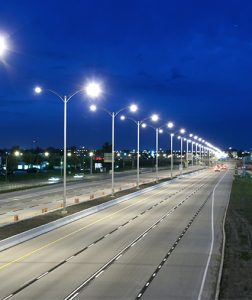
First-class highways, second-class highways: minimum average illuminance maintenance value 20 lx (low standard) / 30 lx (high standard), uniformity minimum value of 0.4;
Third-class highways: minimum average illuminance maintenance value 15 lx (low standard) / 20 lx (high standard), uniformity of 0.4;
Fourth-class roads: average illuminance 10 lx (low standard) / 15 lx (high standard), uniformity of 0.3;
The above illuminance requirements apply only to asphalt roads, and the illuminance requirements for concrete roads can be correspondingly reduced, with a reduction of not more than 30%.
Highway lighting levels should be determined based on the lighting standards of urban roads connected to them, the highway traffic control system, and road partitioning facilities.
The above average illuminance has two standard values, high standard values should be used for the following cases:
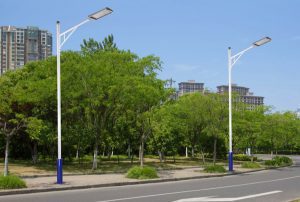
Express roads and main roads: minimum average illuminance maintenance value 20 lx (low standard) / 30 lx (high standard), uniformity minimum value of 0.4;
Secondary roads: minimum average illuminance maintenance value 15 lx (low standard) / 20 lx (high standard), uniformity of 0.4;
Side roads: average illuminance 10 lx (low standard) / 15 lx (high standard), uniformity of 0.3;
The above illuminance requirements apply only to asphalt roads, and the illuminance requirements for concrete roads can be correspondingly reduced, with a reduction of not more than 30%;
City road lighting illuminance values should be determined based on the area where the project is located, road positioning, traffic flow, road partitioning facilities, environmental brightness conditions, and actual needs.
High standard values should be used for the following conditions:
Low standard values are recommended for the following conditions:
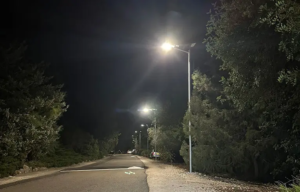
Primary roads: minimum average illuminance maintenance value 10 lx (low standard) / 15 lx (high standard), uniformity minimum value of 0.3;
Side streets and lanes: minimum average illuminance maintenance value 5 lx (low standard) / 8 lx (high standard);
Public activity squares: minimum average illuminance maintenance value 10 lx (low standard) / 15 lx (high standard);
The above illuminance requirements apply only to asphalt roads, and the illuminance requirements for concrete roads can be correspondingly reduced, with a reduction of not more than 30%;
Rural road lighting illuminance values should be determined based on the area where the project is located, road positioning, traffic flow, road partitioning facilities, environmental brightness conditions, and actual needs.
High standard values should be used for the following conditions:
Low standard values are recommended for the following conditions:
When the lighting standards at the intersecting roads are both low standard illuminance values, the intersection area should adopt the low standard value, otherwise, the high standard value should be used.
Contact us for free streetlight engineering design
Kelvin is commonly used as a measurement of the color temperature of a light source. The principle of color temperature is based on the frequency distribution characteristics of light emitted by a blackbody radiator at its temperature. Blackbody temperatures below around 4000K appear reddish, while those above 4000K appear bluish, with 7500K appearing blue.
Generally, the Kelvin temperature of a lamp will fall between 2000K and 6500K.

Kelvin temperatures below 3000 produce warm, calm, and inviting light, suitable for general indoor lighting in homes and businesses. Pros: Shorter wavelength yellow light has strong penetration on rainy days. Cons: Low visibility.
LED lights in the 3000K-4500K range are called neutral light. These bright and vibrant lights are very suitable for workplaces such as basements, factories, and hospitals. Pros: 4000-4500K is closest to natural light, the light is softer and can provide higher brightness while maintaining driver attention. Cons: Not as high visibility as above 5000K.
Lights with Kelvin temperatures in the range of 4500K-6500K are called cool white light, producing a fresh color similar to sunlight. These lights are best when maximum illumination is needed, such as for safety lighting, display cabinets, warehouses, and industrial areas. Highest visibility reduces accidents, especially those above 5700K, are popular for engineering projects. Cons: Can cause fatigue and should not be used in long-term workspaces.
In most countries, four common color temperature options for LED lights are 2700K (some manufacturers write it as 3000K), 3000K, 3500K, 4000K, 5700K (some manufacturers write it as 6000K), with other color temperatures being customized.
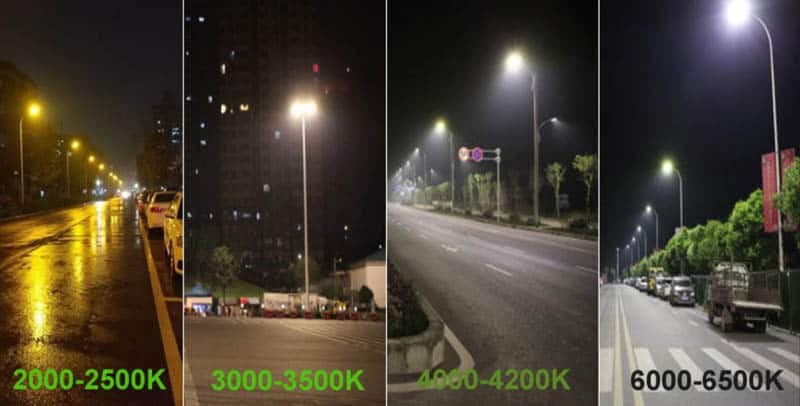
Some countries’ regulations (such as China) specify that the color temperature should not exceed 5000K, preferably choosing a medium to low color temperature. However, many engineering projects in various countries still choose 5700K or even above 6000K because the advantages of high color temperature are also significant, improving visibility and reducing accidents.
According to the technical standards for civil airport flight areas, when using LED as a light source, a lens should be added to control glare, and the color temperature should not exceed 4000K.
For roads with mixed motor vehicle and pedestrian traffic in residential areas, it is advisable to use light sources with low to medium color temperatures, most commonly kept below 4000K.
Lights along rivers and foggy road sections should use low color temperature lights, with a recommended range of 2700K-3500K.
In commercial bustling areas, historic and cultural districts, scenic spots, and other places where color recognition is important for motor vehicle traffic, it is advisable to use high CRI, low to medium color temperature light sources.
5700-6500K is preferable. A 5700K color temperature can help focus attention and make driving safer.
Spotlights, outdoor floodlights, and other landscape lights used in gardens, road decorations, partial lighting, and other outdoor recreational areas. Generally, warm colors of 2700K and 3000K are more suitable, creating a warm and relaxing atmosphere.
Watts (symbol: W) is a unit of power, measuring the amount of energy consumed. When we pay our electricity bill, we are paying for the watts we use. Since we have traditionally used incandescent light bulbs, we are accustomed to using watts as a unit of brightness, but this is incorrect. The measure of the brightness of a light fixture is lumens, not watts.

Lumens are the measurement of visible light energy. The higher the number of lumens, the brighter the light. Lighting fixtures used for illumination are usually labeled with their light output (in lumens), which is legally required in many jurisdictions.
Therefore, when we choose the brightness of the lamp, we only need to look for the lumen value on the package.
If a road contractor asks if we have a 100W solar street light, it is difficult to determine the requirement for how many lumens of solar LED street light they need. To understand the relationship between them clearly, we need to understand Luminous Efficacy (lumens per watt).
This measure indicates how efficiently a light source converts energy (watts) into light (lumens).
Luminous efficacy (lm/W) = lumens (lm)/Watt(W)
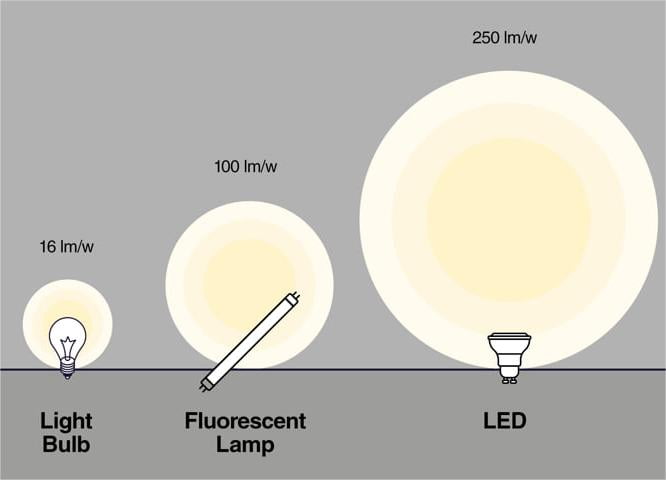
Luminous efficacy of different lamps with the same watt
Based on a 2013 report from energy.gov in the United States, there are LED package standards established at 266 lm/W and PC-LEDs achieving over 130 lm/W, with a successful prediction that by 2024 the luminous efficacy of LEDs will exceed 200 lm/W, showing the importance and expectations for future LED lighting.
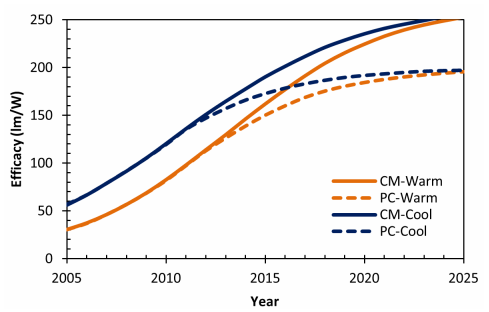
As of 2024, LED technology can indeed achieve a theoretical 230 lm/W (actual usage tested at 200 lm/W). Due to variations in specifications among manufacturers and market supply-demand issues, there are still many LEDs on the market ranging from 130 lm/W to 190 lm/W. Therefore, when selecting the brightness of a light fixture, it is essential to pay attention to lumens.
Incandescent technology typically produces 12-18 lumens per watt, while halogen technology usually produces 10-20 lumens per watt.
Therefore, for the same wattage, the brightness of LED bulbs is approximately 10-14 times that of incandescent bulbs and about 10 times that of halogen bulbs. You can roughly refer to this indicator when choosing light fixtures.
| Lumens | Incandescent Watts | Halogen Watts | LED Watts |
| 100 | 7 | 6 | 0.77 |
| 375 | 25 | 20 | 2.9 |
| 450 | 30 | 25 | 3.5 |
| 800 | 60 | 45 | 6 |
| 1100 | 75 | 60 | 8.5 |
| Lumens to watt | Luminous efficacy(lm/W) | |||
| Lumens | 130 lm/W | 150 lm/W | 180 lm/W | 200 lm/W |
| 100 lm | 0.8w | 0.7w | 0.6w | 0.5w |
| 500 lm | 4w | 3w | 3w | 3w |
| 1000 lm | 8w | 7w | 6w | 5w |
| 2000 lm | 15w | 13w | 11w | 10w |
| 3000 lm | 23w | 20w | 17w | 15w |
| 4000 lm | 31w | 27w | 22w | 20w |
| 6000 lm | 46w | 40w | 33w | 30w |
| 8000 lm | 62w | 53w | 44w | 40w |
| 10000 lm | 77w | 67w | 56w | 50w |
| 15000 lm | 115w | 100w | 83w | 75w |
| 20000 lm | 154w | 133w | 111w | 100w |
Rely on the manufacturer’s provided Luminous Efficacy Test Report.
You can use a lumen calculator to determine this, at https://www.omnicalculator.com/everyday-life/lighting
The number of lumens required for street lights depends on several factors, such as the height of the light pole, the width of the road, and the amount of ambient light available. To determine the appropriate lumen output, recommended illumination levels for different types of roads need to be considered.
Generally, residential streets require around 5,000 to 12,000 lumens per light, while main roads and highways may require higher lumen outputs, typically needing 10,000 to 15,000 lumens to ensure safety.
For guidance on how to choose the light pole height, please refer to the article:HOW TO CALCULATE THE HEIGHT AND DISTANCE OF SOLAR STREET LIGHT POLE?
These are general guidelines that apply to most spaces; however, they may not be applicable to all scenarios. Rooms with darker walls and particularly high ceilings may require additional lumens to achieve the desired effect.
Finally, we recommend you read this article to learn about Light measurement for solar street lighting systems:https://luxmanlight.com/are-solar-street-lights-bright-enough/
https://en.wikipedia.org/wiki/Lumen_(unit)
https://en.wikipedia.org/wiki/Watt
According to the 2024 mainstream model, solar lights are usually set to continue lighting 12 disappear from dusk until dawn. Designed service life of 8~10 years. As a professional solar street light manufacturer, we now use lithium iron phosphate batteries and LED lights to produce solar lights, ensuring they can be used for over 10 years. Lower-quality solar lights may use batteries that last only 3 to 5 years, resulting in short illumination duration and the need for regular battery replacement, which is highly unfriendly.
Luxman strongly recommends using high-quality solar lights and provides a 5-year warranty. Even Luxman’s solar street lights can continue to illuminate for 12 hours every day during seven consecutive rainy days.
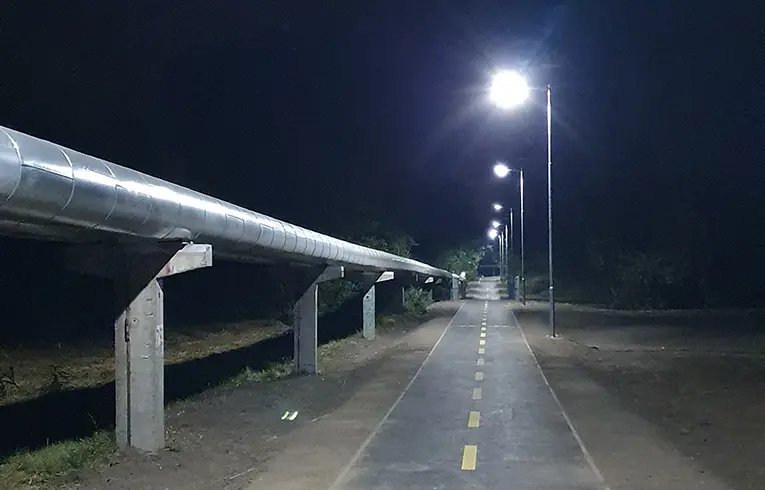
If you want to make full use of the solar panels, you need to clean them regularly to ensure that sunlight reaches them smoothly and that the batteries receive enough power. If manual cleaning seems too troublesome, you can choose or customize solar lights with automatic cleaning, ensuring that the solar panels always perform at their best.
Make sure to install the solar lights in places where sunlight can shine directly on them, ensuring sufficient illumination duration.
Scientific setting of lighting modes
You can use PIR motion sensing modes to adjust the brightness or set lighting brightness according to different time periods, saving more power to ensure longer illumination.
LED lights have more efficient illumination effect, saving energy.
Solar lights can be equipped with temperature control functions to cope with extremely cold and hot weather. If this function is not available, it is best to purchase solar lights with corrosion protection for humid areas and coastal areas. Luxman’s solar lights all have these functions. If your solar lights do not have these functions, please bring them indoors during icy weather in winter.
LiFePO₄ can cycle up to 3000 times and are the most ideal solar batteries.
Recent updates:
https://luxmanlight.com/what-battery-is-best-for-solar-street-lights-in-2024/
https://luxmanlight.com/what-is-the-best-solar-light-battery/
https://luxmanlight.com/how-long-do-solar-powered-street-light-last-luxman-light/
NiCd (Nickel Cadmium) batteries are not one of the best solar battery choices on the market for use in solar energy lights. There’s a debate in the “battery community” about what’s called the “memory effect” with NiCd–these kinds of batteries are meant to be charged fully and depleted fully.
That isn’t what happens often with batteries meant for solar lights, where there’s a constant charge-discharge with the cycles of day and night. The memory effect alters the battery’s voltage levels to shrink over time, where the battery “forgets” the highs and lows it doesn’t often charge to. Typically, the best battery for solar lights (with a properly-sized system) will discharge about 15% every day.
Plus, cadmium is a highly toxic metal which defeats one of the purposes of solar lights–to reduce the environmental impact that the use of energy may have. Many NiCd batteries even have “POISON” stamped across the top. We know most project managers just prefer something that saves money over time, but why not go both routes of cost-effective and environmentally safe?
NiMH (Nickel Metal-Hydride) technology is a better choice over NiCd batteries when it comes to the environment, but there are still some pain points with this selection. There’s a lot of maintenance required with NiMH batteries because they need a full discharge from time to time–we’re sure someone doesn’t want to get the task of discharging every battery in a solar parking lot light configuration.
The best application for these batteries are for small electronics like flashlights and toys since they operate best with high energy consumption and demand instead of small, cyclical power drains or low-energy applications. Still not the best battery solution for solar street lights.
lead-acid battery plate composed of lead and lead oxide, electrolyte for sulfuric acid aqueous solution. Its main advantages are voltage stability and low price. The disadvantage is that the specific energy is low, resulting in a relatively large volume and short service life, about 300-500 deep cycles, requiring frequent routine maintenance. The battery is still widely used in the solar street lamp industry.
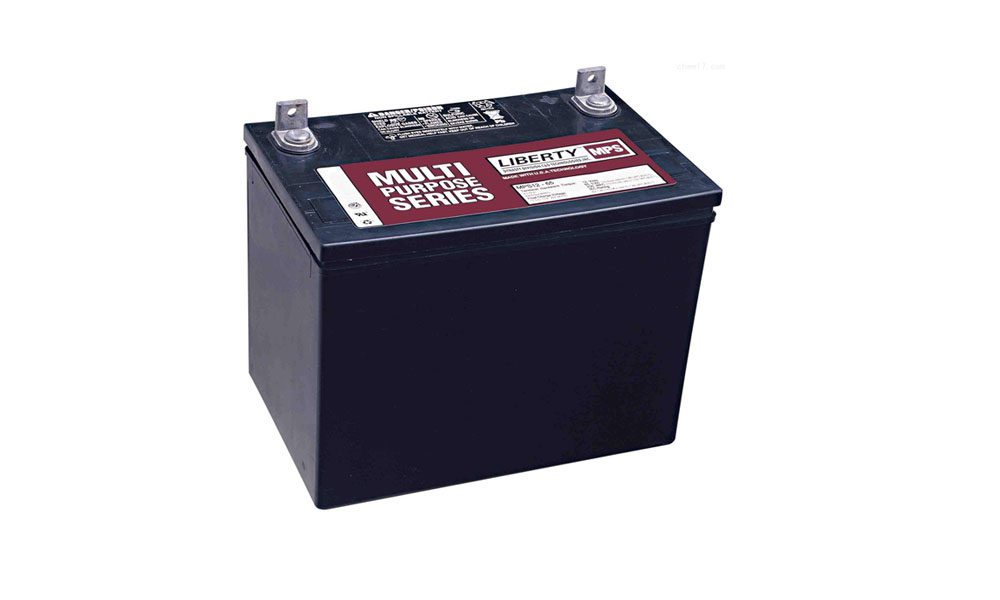
In fact, lead-acid battery is an upgrade of the maintenance free version, through the colloidal electrolyte instead of sulfuric acid electrolyte, in terms of safety, storage, discharge performance and service life than ordinary batteries have been improved, the price of some even higher than three lithium batteries. It can be used in the temperature range of -40℃ to -65℃, especially good performance at low temperature, suitable for the northern alpine region. Strong seismic performance, can be used safely in harsh environments. The service life is about twice as long as the ordinary lead-acid battery。
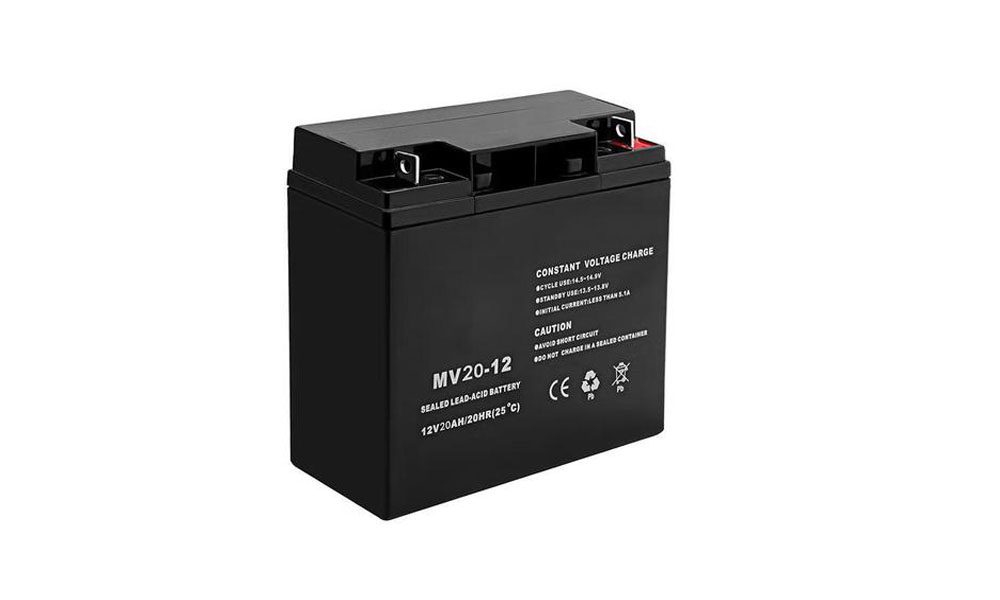
higher than the energy, small size, fast charging, but the price is higher. The number of deep cycles is about 500-800 times, the life of the battery is about 1 times longer than that of the lead-acid battery, and the temperature range is -15℃ to 45℃. However, less stable, unqualified manufacturers of ternary lithium batteries may explode or catch fire when overcharged or too high temperature.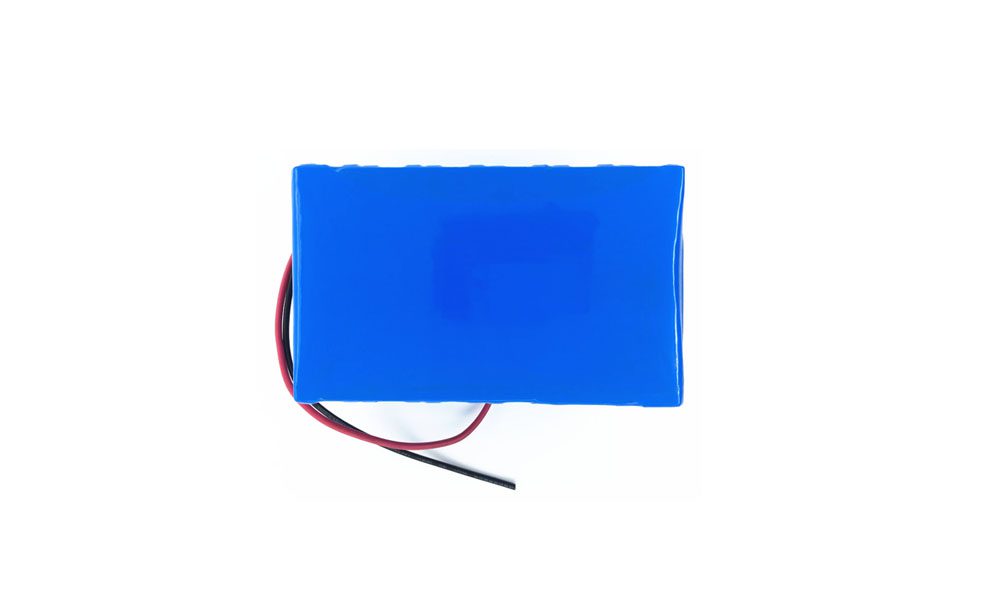
Hgher than the energy, small size, fast charging, long service life, good stability, the price is the highest. The number of deep cycle charging is about 1500-2000 times, long service life, generally up to 8-10 years, strong stability, wide temperature range, can be used in -40℃ to 70℃.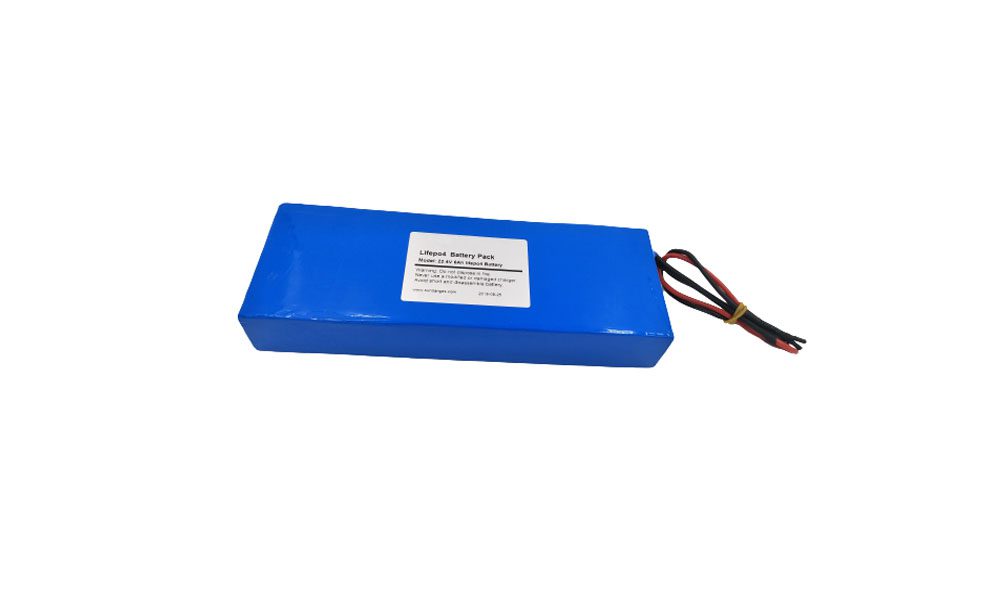
To sum up, solar street lights of course use lithium iron phosphate batteries best, although the price is higher. At present, the market solar street lamp using lithium iron phosphate battery price is very reasonable product, the life of this product can reach 10 years, the price is also very attractive.
Luxman’s solar street lights are all powered by lithium iron phosphate batteries.
https://luxmanlight.com/how-to-choose-the-right-batteries-for-your-solar-light/
https://luxmanlight.com/what-kind-of-batteries-are-used-in-solar-street-lights/